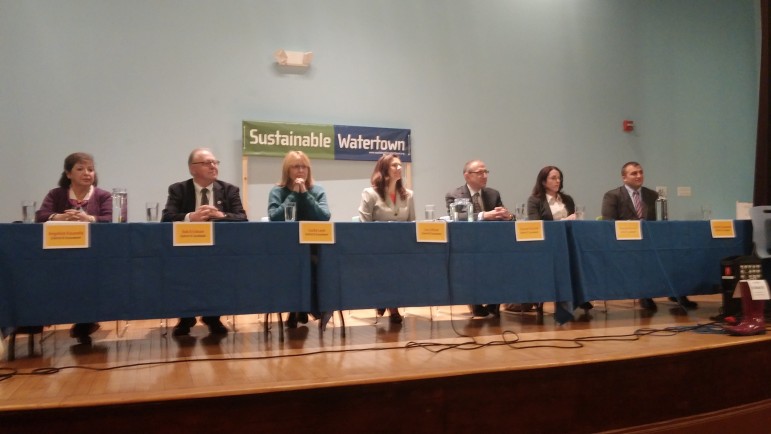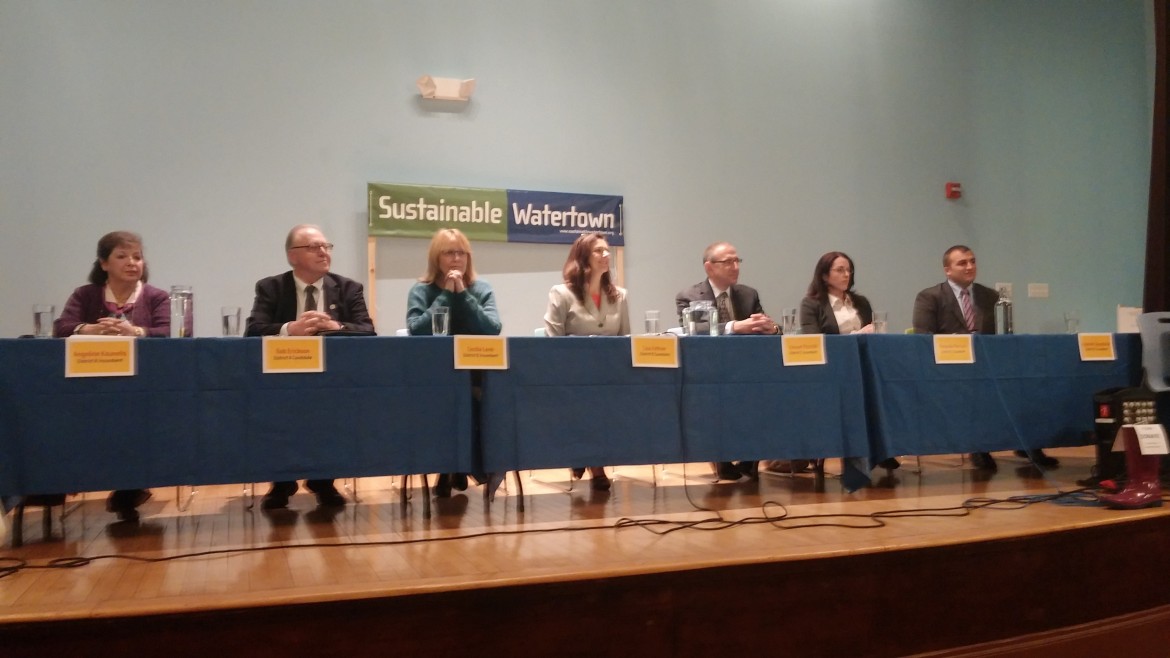
Charlie Breitrose
Candidates for District Councilor appeared at Sustainable Watertown’s Candidate Forum. From left, Angeline Kounelis, Bob Erickson, Cecilia Lenk, Lisa Feltner, Vincent Piccirilli, Rossella Mercuri and Ken Woodland.
The candidates for district councilors made their case at a Candidates Forum hosted by Sustainable Watertown on Sunday evening.
The hopefuls for the council seats, which each represent one quarter of Watertown, talked about issues such as development, the environment and traffic, among other subjects. These are some of the issues that are most important to members of the citizen-run Sustainable Watertown.
The candidates are:
- District A (Precincts 1-3; East Watertown) – incumbent Angeline Kounelis and challenger Bob Erickson
- District B (Precincts 4-6; East of Common and Spring streets to School Street and South of the Charles River) – incumbent Cecilia Lenk and challenger Lisa Feltner
- District C (Precincts 7-9; West of Common and Spring streets to Lexington Street) – incumbent Vincent Piccirilli and challenger Rossella Mercuri
- District D (Precincts 10-12, West Watertown) – incumbent Ken Woodland
Development
Development has been the top issue in Watertown for the past two years, and moderator Pia Owens asked each about their views about whether the town should implement limits on commercial building square footage, frontage and setbacks.
Piccirilli said the new rules in the Design Guidelines and Comprehensive Plans seek to create storefronts like you might have seen in the early 20th century where people can walk the sidewalks and window shop.
Mercuri said she did not want to put limits on things like square footage of a development, stricter set backs, but rather should be looked at on a case-by case basis.
“It needs to be in tune with the neighborhood and the height and size of the building,” Mercuri said.
Limits have already been put into place for the Westside of town with the recently passed Pleasant Street Corridor District zoning changes, Woodland said. This will require mixed use projects to have commercial space on the bottom floor, while having setbacks to protect the Charles River.
Kounelis would like to see an end to the “long blank walls” in some developments in town, and she said Coolidge Square had been successful in creating a small business center.
“The post office is the place where everyone talks to their friends,” Kounelis said. “They talk about their neighborhood, they talk business and they talk gossip.”
Erickson said he would look at projects on a case-by-case basis, and would want input from businesses and the neighborhood.
“It is not one-size fits all, or one style,” Erickson said. “We want investment in our business districts.”
Lenk hopes that the west end of Arsenal Street, which is in her district, can be transformed into a commercial area such as the supermarket and smaller storefronts coming with some of the new apartment developments. Parts of Watertown Square could use reenergizing, and she worries about some properties that have been left vacant.
Feltner said it is important to have vibrant shopping districts, and wants to seek input from the community.
“We want business districts to be local hubs, but we are not seeing that,” Feltner said. “We should identify what people like and how we want to incentivize that. We need to ask the right questions.”
Residential Zoning Changes
The proposed Residential Design Guidelines were also a topic of discussion during the forum. This issue arose when some residents wanted to stop the new trend of tearing down old homes and putting up larger ones or, more often, putting in multiple units in their place.
Feltner said views the design guidelines as a way to help homeowners have a vision for what they can do to improve or expand their home, without having to go through the town’s special permit process and go in front of the Planning and Zoning boards. She is concerned with the tear downs and would like to look at zoning changes to prevent those.
Lenk noted that she was the Councilor to start the ball rolling by referring residential design guidelines to subcommittee.
“We should put in place, whether zoning or guidelines, something that makes sure developments are keeping in character of the neighborhood,” Lenk said.
Erickson said he has heard stories of a person selling a home, and next thing they know it is a hole in the ground and being redeveloped. He worries about how much pressure could be put on developers.
“If a builder wants to do a duplex and everyone is against it, how much clout does the neighborhood have?” Erickson said.
Property rights are at stake in the design guideline discussion, Kounelis said. She noted that not every redevelopment has been controversial, noting that a home on Prentiss Street in the East End was replaced and she never heard a complaint.
While all neighborhoods are different, Woodland said, the guidelines can provide some universal standards such as setbacks, step backs, and dealing with stormwater.
Mercuri worried about trying to apply one standard to a wide range of homes in Watertown and even in one area.
“Not only is every neighborhood diverse, but every every home is diverse,” Mercuri said. “Every home is unique and should be left to the homeowners, perhaps with guidance from the Council and community.”
The town should tread lightly, but can still push for what it would like to see in new residential developments, Piccirilli said.
“I agree we need to proceed carefully – people have property rights,” Piccirilli said. “We need to provide homeowners with incentives.”
Traffic
All candidates agreed traffic was a huge problem for Watertown.
Improving public transportation on Pleasant Street would help the West End, Woodland said, who noted rhe problem is both internal and external, Woodland said.
“Almost as many people leave town for work as are coming in to work,” Woodland said.
Piccirilli said Watertown’s streets were laid down in the 19th century, and we are going to have to work with them. He said changes could be made a key intersections, such as left turn lanes, to improve traffic flow.
Mercuri said Watertown is not walkable, and she sees the traffic problem only getting worse with new developments just adding more cars to the road.
To improve traffic in Watertown, Lenk said the town needs to think regionally. she said she meets regularly with elected counterparts in Newton because traffic from Pike exits there impact Watertown. Also, she thinks a new collaboration between Watertown, Newton and Waltham, to create the Charles River Mill District could help.
Feltner said the town has allocated money for a transportation planner, and she would like to see it become a full-time person. While she has seen plans to improve traffic, some take away on-street parking and she worries that might negatively impact businesses.
Kounelis said the town needs to put pressure on the MBTA to improve bus service in town.
Erickson suggested asking companies to stagger when they let employees arrive at and leave work, plus adding programs such as Hubway could encourage people to ride bicycles rather than driving.
Environment
Each candidate was asked what their top priority for environmental sustainability and reducing the carbon footprint.
The town has come a long way since you could watch dies flowing from factories directly into the river, Erickson said. He recently had his own home checked for energy efficiency and added LED lights. He also would like to see more trees planted around town.
Stormwater is a big issue in keeping the Charles River clean, Kounelis said. One step she suggested is people can help out by sweeping sand and other debris from storm catch basins to make sure they do not get into the river. She also helped get energy-efficient LED lights installed in Coolidge Square.
Feltner worries about the cleanliness of the Charles River, and said the town is in danger of being fined by the state for polluting the river with stormwater. This is an area she said where she would like to see Watertown not have to react to a crisis but get ahead of the game.
Stormwater and leaking sewer pipes are a problem, Lenk said, and contribute to polluting the river. While fixing infrastructure is not exciting, the town needs to repair its aging sewer pipes.
Mercuri said the developers come to town looking to build, it is the town’s opportunity to have them build sustainable buildings, cut the number of parking spaces or even require having green roofs.
Reducing the pollution going into the Charles River was Piccirilli’s top priority. The town’s sewers need to be upgraded, but it will cost a lot of money.
Woodland’s top priority is the Charles River, and he would also like to see green initiatives for new developments and town-owned buildings, too.
